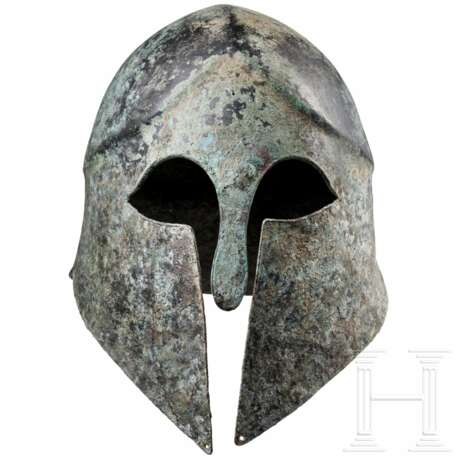Korinthischer Helm der entwickelten dritten Stufe mit Merkmalen der Lamia-Gruppe, letztes Drittel 6. - frühes 5. Jhdt. v. Chr.
06.05.2023 10:00UTC +01:00
Classic
Vendu
38000EUR € 38 000
| Auctioneer | Hermann Historica |
|---|---|
| Lieu de l'événement | Allemagne, Grasbrunn / München |
| Commission | 25 % |
Archive
La vente aux enchères est terminée. Vous ne pouvez plus enchérir.

ID 946712
Lot 16 | Korinthischer Helm der entwickelten dritten Stufe mit Merkmalen der Lamia-Gruppe, letztes Drittel 6. - frühes 5. Jhdt. v. Chr.
Valeur estimée
€ 38 000
Durchbohrungen zur Befestigung eines Helmkamms nahe dem Zwickel des Stirngiebels, beidseitig des Scheitelknicks in der Kalotte knapp hinter dem Stirngiebel und hinten auf dem Scheitelknick, knapp oberhalb des Nackenschirms. Ferner Reste eines Dorns im hinteren Bereich der Kalotte auf dem Scheitelknick. Länge unten von den Spitzen der Wangenklappen zur Kante des Nackenschutzes 26 cm. Höhe ca. 27 cm. Breite an den seitlichen Zwickeln 21 cm, maximale Breite des Nackenschutzes 22 cm.
Ausgezeichnet erhaltener Bronzehelm ohne Fehlstellen, die abgebrochene rechte Wangenklappe wieder angesetzt. Verbogene Stellen auf der linken Seite bei Wandung und Nackenschutz zurückgeformt. Dunkelgrüne, partiell glänzende Patina mit Inkrustationen darüber.
Selten gut erhaltenes Exemplar eines späten korinthischen Helmes mit strenger, klar strukturierter Formgebung, die gerade in ihrer Schlichtheit ohne Verzierung besonders eindrucksvoll wirkt. Helme dieser Gruppe konnten auch nach hinten geschoben getragen werden, sodass das sonst verdeckte Antlitz des Kriegers sichtbar wurde. Bildnisse der Pallas Athene zeigen sie häufig mit einem solchermaßen auf dem Hinterhaupt getragenen Helm. Der auf zahlreichen Werken der Skulptur und Vasenmalerei dargestellte Helmtyp gilt vielfach als Inbegriff des griechischen Helmes schlechthin.
Provenienz: Süddeutsche Privatsammlung, erworben aus anderer Privatsammlung, vom Vorbesitzer in den 90er Jahren auf süddeutscher Kunstmesse erworben.
A Corinthian helmet of the developed third stage with features of the Lamia group, last 3rd of the 6th - early 5th century B.C.
Beautifully shaped and above averagely well preserved example of a developed Corinthian helmet. Apart from a minor dent on the left side, the impeccably preserved calotte is set off from the wall by a slightly undercut bend and has a shallow edge along the crown. The wall is drawn upwards like a gable at the forehead, merging into a tongue-shaped nasal at the bottom, with arched cutouts for the eyes at the sides, ending in a spandrel at the back. From this spandrel run the inwardly curving front parts of the cheek guard, which are extended far downwards, leaving only a narrow slit into which the nasal projects. A hole in the lower tips of the left and right cheek guards. The edges of the nasal, eye cutouts and inner sides of the cheek flaps thickened into a narrow rib. Otherwise, as is typical of representatives of this helmet group, no decoration. The neck shield, which swings outwards from the wall in a slight curve, is separated from the cheek flaps by an obtuse-angled spandrel.
Holes for attaching a helmet crest near the spandrel of the frontal gable, on both sides of the crown edge in the calotte just behind the frontal gable and at the back on the crown edge, just above the neck shield. Furthermore, remains of a spine in the rear of the calotte on the crown edge. Length at the bottom from the tips of the cheek flaps to the edge of the neck guard 26 cm. Height approximately 27 cm. Width at the side spandrels 21 cm, maximum width of the neck guard 22 cm.
Excellently preserved bronze helmet without missing parts, the broken right cheek flap reattached. Bent areas on the left side of the wall and neck guard moulded back. Dark green, partially shiny patina with incrustations on top. Rare, well-preserved example of a late Corinthian helmet with a strict, clearly structured design, which is particularly impressive in its simplicity without ornamentation. Helmets of this group could also be worn pushed backwards, so that the otherwise concealed face of the warrior became visible. Portraits of Pallas Athena often show her with such a helmet worn on the back of her head. This type of helmet, depicted in numerous works of sculpture and vase painting, is often regarded as the epitome of the Greek helmet par excellence.
Provenance: South German private collection, acquired from another private collection, purchased by the previous owner at a South German Art Fair in the 1990s.
Condition: I - II
| Lieu d'origine: | Grèce antique |
|---|
| Lieu d'origine: | Grèce antique |
|---|
| Adresse de l'enchère |
Hermann Historica Bretonischer Ring 3 85630 Grasbrunn / München Allemagne | ||||||||||||||
|---|---|---|---|---|---|---|---|---|---|---|---|---|---|---|---|
| Aperçu |
| ||||||||||||||
| Téléphone | +49 (0)89 5472 649 0 | ||||||||||||||
| Fax | +49 (0)89 5472 64999 | ||||||||||||||
| Commission | 25 % | ||||||||||||||
| Conditions d'utilisation | Conditions d'utilisation | ||||||||||||||
| Heures d'ouverture | Heures d'ouverture
|


